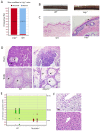Histopathology reveals correlative and unique phenotypes in a high-throughput mouse phenotyping screen
- PMID: 24652767
- PMCID: PMC4007403
- DOI: 10.1242/dmm.015263
Histopathology reveals correlative and unique phenotypes in a high-throughput mouse phenotyping screen
Abstract
The Mouse Genetics Project (MGP) at the Wellcome Trust Sanger Institute aims to generate and phenotype over 800 genetically modified mouse lines over the next 5 years to gain a better understanding of mammalian gene function and provide an invaluable resource to the scientific community for follow-up studies. Phenotyping includes the generation of a standardized biobank of paraffin-embedded tissues for each mouse line, but histopathology is not routinely performed. In collaboration with the Pathology Core of the Centre for Modeling Human Disease (CMHD) we report the utility of histopathology in a high-throughput primary phenotyping screen. Histopathology was assessed in an unbiased selection of 50 mouse lines with (n=30) or without (n=20) clinical phenotypes detected by the standard MGP primary phenotyping screen. Our findings revealed that histopathology added correlating morphological data in 19 of 30 lines (63.3%) in which the primary screen detected a phenotype. In addition, seven of the 50 lines (14%) presented significant histopathology findings that were not associated with or predicted by the standard primary screen. Three of these seven lines had no clinical phenotype detected by the standard primary screen. Incidental and strain-associated background lesions were present in all mutant lines with good concordance to wild-type controls. These findings demonstrate the complementary and unique contribution of histopathology to high-throughput primary phenotyping of mutant mice.
Keywords: High-throughput phenotyping; Histopathology; Mouse; Pathology.
Figures





References
-
- Beckers J., Wurst W., de Angelis M. H. (2009). Towards better mouse models: enhanced genotypes, systemic phenotyping and envirotype modelling. Nat. Rev. Genet. 10, 371–380 - PubMed
-
- Boyce R. W., Dorph-Petersen K. A., Lyck L., Gundersen H. J. (2010). Design-based stereology: introduction to basic concepts and practical approaches for estimation of cell number. Toxicol. Pathol. 38, 1011–1025 - PubMed
-
- Brayton C. (2006). Spontaneous diseases in commonly used inbred mouse strains. In The Mouse in Biomedical Research: ACLAM Series, 2nd edn, Vol 3 (ed. James G., Fox J. G., Barthold S., Davisson M., Newcomer C. E., Quimby F. W., Smith A.), pp. 647–651 Burlington, MA: Academic Press
-
- Bronson R. T. (2001). How to study pathologic phenotypes of knockout mice. Methods Mol. Biol. 158, 155–180 - PubMed
Publication types
MeSH terms
Grants and funding
LinkOut - more resources
Full Text Sources
Other Literature Sources
Molecular Biology Databases
Miscellaneous

